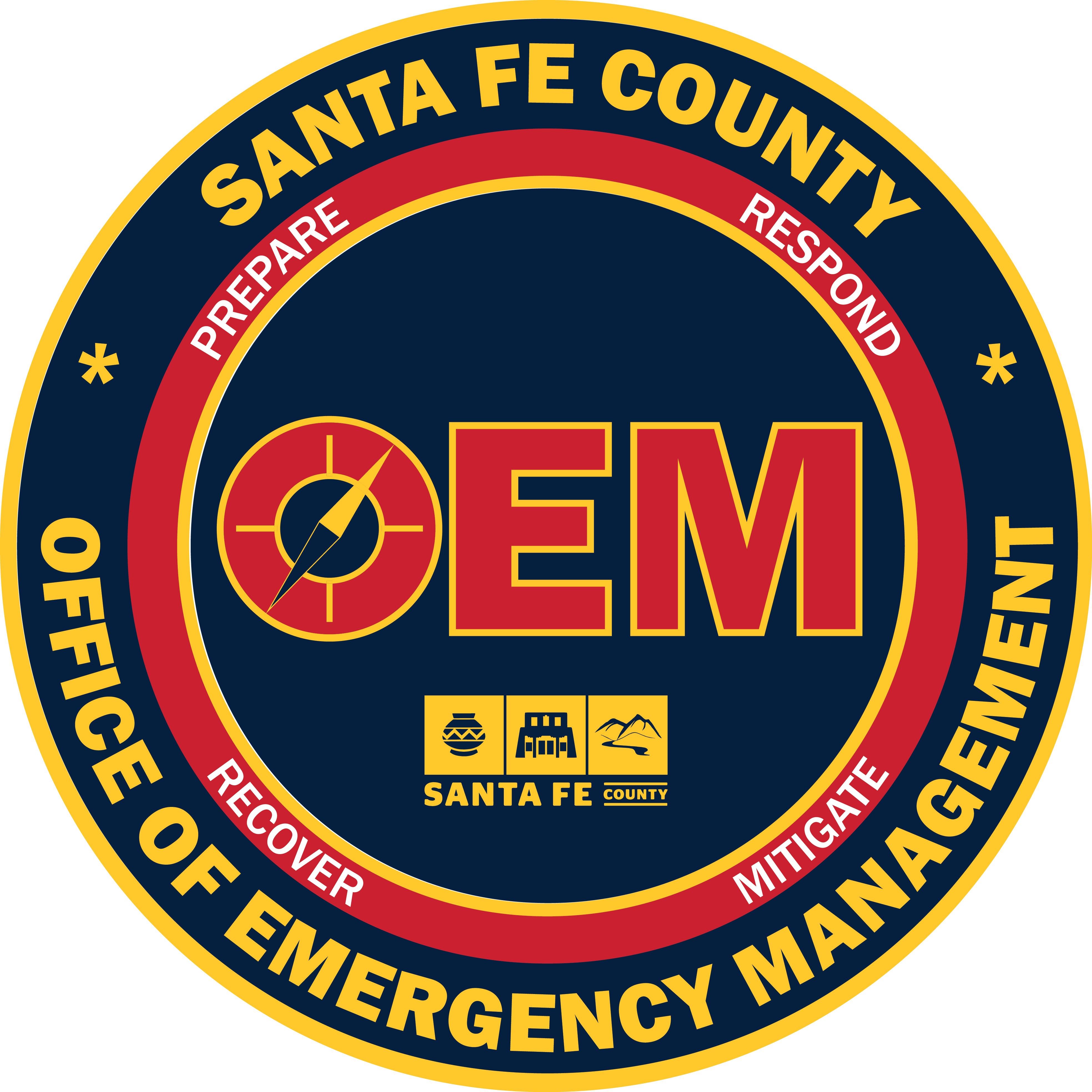
An Evacuation Planning Guide for the Residents of Santa Fe County and the City of Santa Fe.
Santa Fe County is at risk of wildfire. You and your family should prepare a family evacuation plan before a wildfire threatens. The following information will help you and your family prepare for the real possibility that you may need to evacuate your home secondary to a fire or other emergency event.
Click on any topic below to read more information.
GET READY: Preparation and Planning »
Get Ready
Make Plans with your Family:
- If possible, include your appropriate aged children in preparation planning.
- Emergency Contacts and Family Gathering Location. Where will your family members gather or make contact with other family members? Pre-designate meeting areas and contact numbers. Identify who your out-of-area family member or friend (emergency contact) will be. This person will collect information from others calling in, their location, condition and status, and relay to other in-area family members.
- Pets. Have a pet evacuation plan as well. How will you transport any pet during an evacuation? Where will they be housed? Pets are not allowed in Red Cross Shelters. If you have large animals contact Animal Control or the Humane Association.
- Road Closures/Alternative Routes. Law enforcement authorities may be forced to close roads during a declared emergency. Make sure your evacuation plan includes the possibility that you may not be home, but other family members or pets may be. If possible identify alternative routes. Do you live on a road that has one way in and one way out? If so, make sure you discuss these facts with all family members and identify safe areas to gather if you cannot get out.
- School Aged Children. Check with your child's school for the school's Student Release Policy. The school should have plans to shelter or bus your children to a safe location. To avoid mass confusion and congestion make plans to pick up your child at school after the immediate crisis has passed.
- Latch-key Kids. Discuss emergency plans in case you are unable to return home.
Important Stuff:
Make a list of important items that you need or use on a daily basis. The following are examples. Make your own list and gather items in advance.
- Prescription drugs.
- Eyeglasses or Contact lenses.
- Important documents.
- Keep your "Important Stuff" list handy.
- Keep sturdy boxes ready for collecting things on your list.
- Prepare an Emergency Supply Kit.
Emergency Supply Kit:
In an emergency you will not have time to shop or gather supplies. Assemble a 72-hour emergency kit that is readily available.
|

|
- 3-Day emergency water supply (1 gallon per day per person)
- 3-Day emergency food supply that will not spoil and a way to open containers
- One change of clothing per person
- Blankets or sleeping bags
- Battery powered radio with spare batteries (AM capable to receive KOB 770 Emergency Alert Station)
- Flashlight with spare batteries
- Toiletry supplies
|
GET SET: Put Your Plan into Action »
Get Set
When evacuation seems imminent put your plan to into action
- Remember: HUMAN LIFE IS ALWAYS THE PRIORITY
- Park your car facing out to expedite departure
- Load your 72-hour Emergency Supply Kit
- Load your Important Stuff
- Load pets last
- Then, if there is time....
- Close windows and metal window blinds.
- Close doors, but do not lock. Firefighters may need access to protect your home.
- Cluster lawn furniture and other items that may snag fire hose in out-of-way areas.
- Remove light curtains and other combustibles away from windows.
- Leave exterior lights on - it helps firefighters find your home in dark or smoky conditions.
- Leave sprinklers OFF. Maintaining system water pressure is important for fire fighting capabilities.
- Hang bright pink or green flagging or ribbon (3-4 ft long) from your door or front gate to let emergency personnel know the home has been evacuated.
GO: What to do in the Event of a Fire »
Get Moving - Go!
- Don't wait to be told to evacuate. Authorities may not have time to order an evacuation. If you feel threatened, leave on your own initiative.
- Obey law enforcement and fire officers. They understand the risk and act on current fire information and are concerned for your safety.
- Drive with your headlights on. Drive carefully. Leave room for fire trucks, they are not as maneuverable as smaller vehicles.
- Do not block access roads. Emergency vehicles must have clear lanes to the fire.
- If fire overtakes you, stay in the car. It is far safer inside your car than out.
- Do Not Call 911 for non-emergencies. Emergency Contact Numbers will be announced over the emergency communications network, listen for these numbers on your car or battery-powered radio.
- Do not attempt to re-enter the area until after officials have declared it is safe to return.
- Check in at the designated Red Cross Evacuation Center. Even if you do not utilize emergency housing, or require assistance, the Red Cross is responsible for tracking contact names and numbers for evacuees. Checking in will ensure others know you are safe.
Meet
Please check in at the designated Red Cross Evacuation Center. This information will be broadcast over the emergency communications network.
Everyone in Santa Fe County who evacuates during a wildfire is asked to tune to the Emergency Communications Network station (770 am) for specific directions on where to register.Even if you do not utilize emergency housing or require assistance it is important for citizen accountability. The Red Cross has been tasked with tracking contact information from evacuees. Checking in will ensure others know that you are safe.
Other Important Resources
Red Cross: www.redcross.org/services/disaster
US Department of Homeland Security: www.ready.gov

